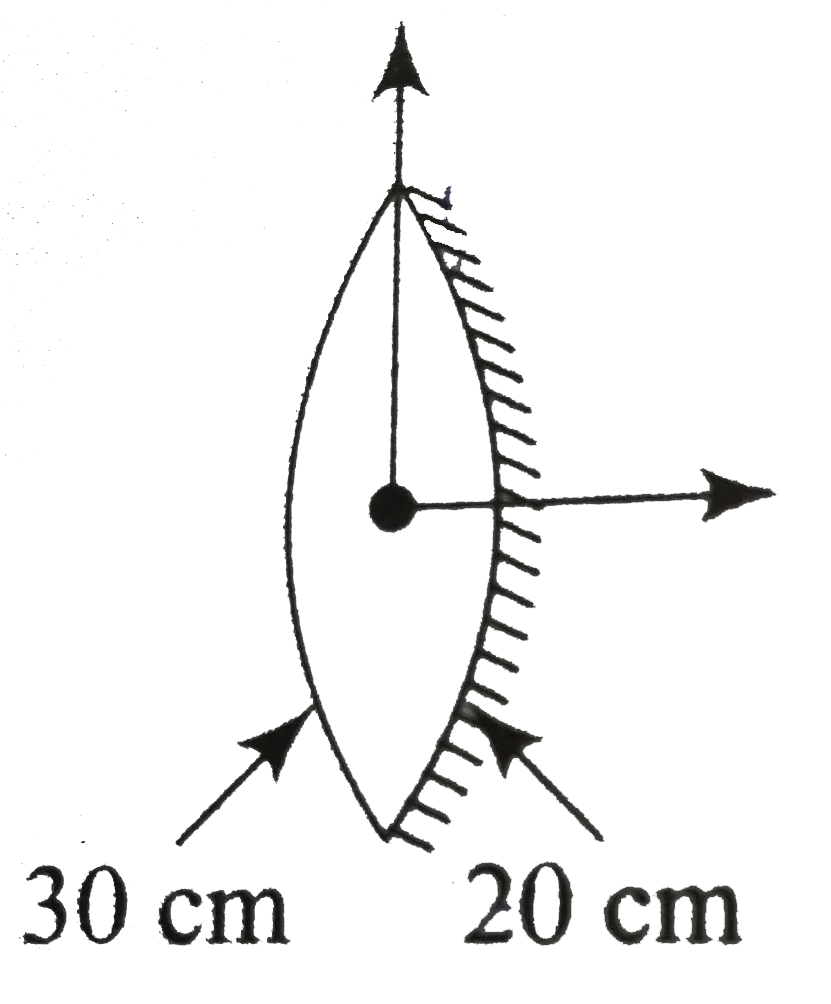A biconvex lens made of glass (refractive index 1.5) has two spherical surfaces having radii 20cm and 30cm. Calculate its focal length.
To find the focal length of a biconvex lens, we can use the Lensmaker's formula, which is given by:
1f=(n−1)(1R1−1R2)
where:
- f is the focal length of the lens,
- n is the refractive index of the lens material,
- R1 is the radius of curvature of the first surface (positive for a biconvex lens),
- R2 is the radius of curvature of the second surface (negative for a biconvex lens).
Step 1: Identify the given values
- Refractive index n=1.5
- Radius of curvature of the first surface R1=20cm
- Radius of curvature of the second surface R2=−30cm (negative because it is on the opposite side)
Step 2: Substitute the values into the Lensmaker's formula
Using the values in the formula:
1f=(1.5−1)(120−1−30)
Step 3: Simplify the equation
Calculate (1.5−1):
1.5−1=0.5
Now calculate 120−1−30:
120+130=360+260=560=112
Now substitute back into the equation:
1f=0.5(112)
Step 4: Calculate 1f
1f=0.512=124
Step 5: Find the focal length f
Taking the reciprocal gives:
f=24cm
Final Answer
The focal length of the biconvex lens is 24cm.
---
- f is the focal length of the lens,
- n is the refractive index of the lens material,
- R1 is the radius of curvature of the first surface (positive for a biconvex lens),
- R2 is the radius of curvature of the second surface (negative for a biconvex lens).
- Refractive index n=1.5
- Radius of curvature of the first surface R1=20cm
- Radius of curvature of the second surface R2=−30cm (negative because it is on the opposite side)
Using the values in the formula:
Calculate (1.5−1):
1f=0.512=124
Taking the reciprocal gives:
The focal length of the biconvex lens is 24cm.
Similar Questions
A concavo-convex lens is made of glass of refractive index 1.5. The radii of curvature of its two surfaces are 30cm and 50cm. Its focal length when placed in a liquid of refractive index 1.4 is
View SolutionA biconvex lens is made of glass with refractive index 1.5 and has radii of curvature 20 cm and 30 cm. If the 20 cm surface is silvered, what is the effective focal length of the mirror formed?

View Solution
Knowledge Check
A double convex lens made of glass of refractive index 1.56 has both radii of curvature of magnitude 20cm. If an object is placed at a distance of 10cm from this lens, find the position of image formed.
A22.86 same side of the objectB22.86 opposite side of the objectC44.89 same side of the objectD44.89 opposite side of the object.
A plano convex lens is made of glass of refractive index 1.5. The radius of curvature of its convex surface is R. Its focal length is
View SolutionAn equiconvex lens is made from glass of refractive index 1.5. If the radius of each surface is changed from 5cm to 6cm, then the power
View SolutionWhen an object is placed 60cm in front of a diverging lens, a virtual image is formed 20cm from the lens. The lens is made of a refractive index μ=1.65 and its two spherical surfaces have the same radius of curvature. What is the value of this radius?
View SolutionA convex lens of refractive index 1.5 has a focal length of 20 cm in air. Calculate the change in its focal length when it is immersed in water of refractive index 4/3.
View SolutionA thin convex lens which is made of glass (refractive index 1.5) has a focal length of 20 cm. It is now completely immersed in a transparent liquid having refractive index 1.75. Find the new focal length of the lens.
View SolutionA double convex thin lens made of glass (refractive index μ=1.5) has both radii of curvature of magnitude 20 cm . Incident light rays parallel to the axis of the lens will converge at a distance L such that
View SolutionA double convex thin lens made of glass (refractive index μ=1.5) has both radii of curvature of magnitude 20 cm . Incident light rays parallel to the axis of the lens will converge at a distance L such that
View Solution